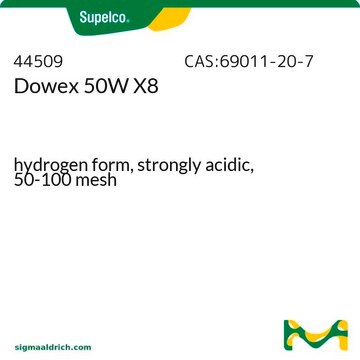2055105
Inlet Liner, Split Type, Cup Design (packed with 10% OV-1 on Chromosorb W HP)
pkg of 5 ea
About This Item
Recommended Products
packaging
pkg of 5 ea
L × O.D. × I.D.
78.5 mm × 6.3 mm × 4.0 mm
Looking for similar products? Visit Product Comparison Guide
Related Categories
General description
- Fits Agilent (5890, 6890, and 7890)
- Fits Finnigan (9001GCQ)
- Fits Varian (CP-1177 Injector)
OV-1 is a modified silicone polymer which has good temperature stability. It is suitable as liquid phases in chromatography. The least polar is a dimethylsilicone which is sold under the mane OV-1.
Chromosorb W, a fragile white solid prepared heating the diatomaceous earth with a flux. The resulting fine structure is cemented over glass which results in large and irregular pores. HP is the classification of a support as high performance grade.
Signal Word
Danger
Hazard Statements
Precautionary Statements
Hazard Classifications
STOT RE 1 Inhalation
Target Organs
Lungs
Storage Class Code
6.1C - Combustible acute toxic Cat.3 / toxic compounds or compounds which causing chronic effects
WGK
WGK 1
Flash Point(F)
214.0 °F - closed cup
Flash Point(C)
101.1 °C - closed cup
Regulatory Listings
Regulatory Listings are mainly provided for chemical products. Only limited information can be provided here for non-chemical products. No entry means none of the components are listed. It is the user’s obligation to ensure the safe and legal use of the product.
JAN Code
2055105:
Choose from one of the most recent versions:
Certificates of Analysis (COA)
It looks like we've run into a problem, but you can still download Certificates of Analysis from our Documents section.
If you need assistance, please contact Customer Support.
Already Own This Product?
Find documentation for the products that you have recently purchased in the Document Library.
Global Trade Item Number
| SKU | GTIN |
|---|---|
| 2055105 | 4061833406236 |
Our team of scientists has experience in all areas of research including Life Science, Material Science, Chemical Synthesis, Chromatography, Analytical and many others.
Contact Technical Service








